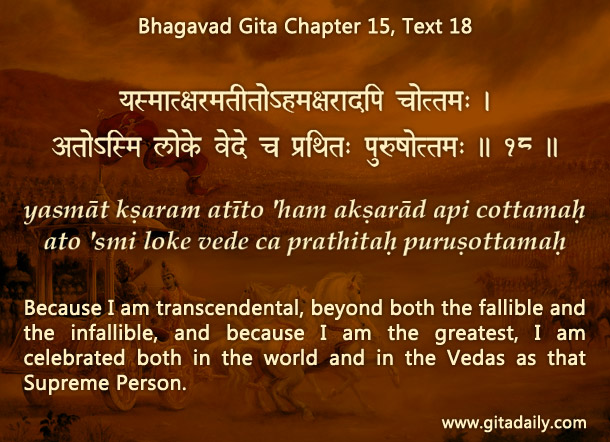A puzzling feature of the Bhagavad-gita is Krishna’s referring to himself sometimes in the third person. One way to make sense of such references is by considering the triune conception of divinity provided by the Gaudiya Vaishnava tradition. This conception involves three aspects of divinity: Brahman, the all-pervading impersonal effulgence; Paramatma, the immanent manifestation who exists within hearts and within the worlds; and Bhagavan, the all-attractive transcendental person who exists in the spiritual world.
These three aspects are the same in that they are manifestations of the same one ultimate reality. And they are different in that each of these manifestations exists simultaneously and distinctly. This conception of inconceivable oneness-and-difference or unity-and-diversity helps in understanding Krishna’s third-person reference.
Consider the fifteenth chapter (15.17-18). He uses the third-person reference for the divinity who has entered into the universe (15.17) and the first-person reference for Purushottama, the transcendental supreme person (15.18). Consider how he describes the vision of the yogis as they progress toward the highest realization (06.29-30). He uses the third-person reference when their realization is at the Paramatma level (06.29) and the first-person reference when their realization has risen to the Bhagavan level (06.30).
Consider also the Gita’s riveting conclusion. Krishna uses the third-person reference for the indwelling divinity (18.61) who is the object of surrender (18.62). But seeing Arjuna lost in thought, unable to decide, Krishna’s affection for Arjuna increases and floods his heart (18.64). He stops speaking as the dispassionate observer (Paramatma) and starts speaking as the impassioned lover (Bhagavan). Naturally, he adopts the first-person reference in the final call for surrender that is the Song of God’s devotional crescendo (18.66).
One-sentence summary:
When discussing the Paramatma manifestation of Divinity, Krishna sometimes uses the third-person reference; when discussing the Bhagavan manifestation, Krishna usually uses the first-person reference.
Think it over:
- What is the triune conception of divinity?
- How are the Paramatma and Bhagavan same and different?
- Using the Paramatma-Bhagavan dynamic, explain any one Gita section where Krishna uses both the third person and the first person.
***
15.18: Because I am transcendental, beyond both the fallible and the infallible, and because I am the greatest, I am celebrated both in the world and in the Vedas as that Supreme Person.
To know more about this verse, please click on the image


Nice. please keep it up
Profound philosophy explained well. Thanks prabhu
Happy to be of service.
“Krishna’s affection for Arjuna increases and floods his heart”
What a beautiful way to describe the emotions in 18.64 and overall the explanation of first-person and third-person reference.
Thank you for your wonderful service.
Thanks for highlighting that sentence and for your specific appreciation. Happy to be of service.